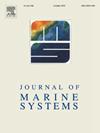Different response of hydrodynamics and near-bottom sediment transport to a cold front in the Changjiang Estuary and its submerged delta
IF 2.5
3区 地球科学
Q2 GEOSCIENCES, MULTIDISCIPLINARY
引用次数: 0
Abstract
Cold fronts are expected to exert a significant impact on hydrodynamics and sediment dynamics in estuaries, but the exact influence remains insufficiently understood. In this study, we provided an in-depth examination of cold front impact based on a 13-day in-situ observation in the South Passage of the Changjiang Estuary. We deployed two bottom-mounted tripod systems and several buoy stations to collect current velocities, wave heights, wind speeds, near-bottom suspended sediment concentrations (SSC), and bed level changes. Data analyses indicated that the maximum wind speed reached over 20 m/s, with significant wave heights of 1.38 m and 2.66 m inside and outside the South Passage, respectively. Wave-induced bed shear stress predominantly contributed to the total shear stress, and reached up to 0.81 N/m2 outside the South Passage. Near-bottom SSC increased by 31 % and 20 % inside and outside the South Passage, respectively, during the post-frontal period, compared to the frontal passage period. The cold front event intensified both the longitudinal circulation in the South Passage and the transverse transport intensity outside the South Passage, leading to a shift in sediment transport direction and landward sediment transport towards the South Passage during the post-frontal period. The cold-front-induced bed shear stress resulted in sediment resuspension in the submerged delta, thereby facilitating a more homogeneous vertical distribution of suspended sediment in the bottom boundary layer. These findings provide insights into the impact of episodic events on water-sediment exchanges at the estuary-ocean interface.
长江口及其水下三角洲冷锋对水动力和近底输沙的不同响应
预计冷锋会对河口的水动力学和沉积物动力学产生重大影响,但确切的影响仍不充分了解。本文基于长江口南通道13天的现场观测,对冷锋影响进行了深入的研究。我们部署了两个底部安装的三脚架系统和几个浮标站来收集流速、浪高、风速、近底部悬浮沉积物浓度(SSC)和床面变化。数据分析表明,最大风速达到20 m/s以上,南通道内外显著浪高分别为1.38 m和2.66 m。波浪诱发的床层剪应力对总剪应力的贡献最大,在南通道外达到0.81 N/m2。与锋面通过期相比,后锋期南通道内外近底部SSC分别增加了31%和20%。冷锋事件增强了南通道的纵向环流和南通道外的横向输沙强度,导致后锋面期输沙方向和向南通道的陆向输沙转移。冷锋诱发的河床剪切应力导致了水下三角洲沉积物的再悬浮,使得底部边界层悬浮沉积物的垂向分布更加均匀。这些发现提供了对河口-海洋界面水-沉积物交换的偶发事件影响的见解。
本文章由计算机程序翻译,如有差异,请以英文原文为准。
求助全文
约1分钟内获得全文
求助全文
来源期刊

Journal of Marine Systems
地学-地球科学综合
CiteScore
6.20
自引率
3.60%
发文量
81
审稿时长
6 months
期刊介绍:
The Journal of Marine Systems provides a medium for interdisciplinary exchange between physical, chemical and biological oceanographers and marine geologists. The journal welcomes original research papers and review articles. Preference will be given to interdisciplinary approaches to marine systems.
 求助内容:
求助内容: 应助结果提醒方式:
应助结果提醒方式:


